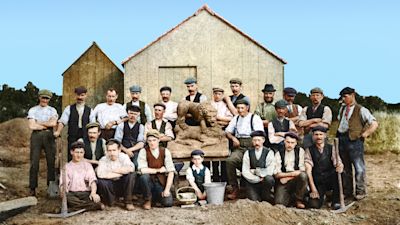Local workers who unearthed Corbridge Roman Town on Hadrian's Wall remembered in new exhibition

A new photo exhibition has opened at Corbridge Roman town, telling the stories of the local labourers who unearthed the internationally renowned site.
Thousands of people have worked on excavations over the years but little is known about those who discovered the now treasured artefacts.
Research by English Heritage has identified some of the men, including Marian Fairless's great uncle, who was involved in the discovery of the Corbridge Lion.
Surtees Foster worked at the site when he was just 13-years-old. It was his first job out of school. A photo of the group has been colourised as part of the display.
Surtees sits proud in the centre of the photo with his bucket and scrubbing brush.
As part of Hadrian's Wall's 1900th anniversary celebrations, Extraordinary Exploration; The Edwardian discovery of Coria showcases dozens of photographs of the local labourers who worked and trained as archaeological excavators at Corbridge over nine years.
The site, name Coria in Latin, was excavated between 1906 and 1914 as part of research for a local history book.
Local labourers - including brick makers, miners and gardeners - with no experience in archaeology were drafted in to do the digging. In the process, they discovered objects and buildings of international importance.
New research carried out by English Heritage has named 11 of the men and the charity hopes the newly colourised photographs will honour the work they did and lead to more excavators being identified.
"The back-breaking work at the heart of these excavations really was phenomenal, especially considering how deep many of the remains were buried," says English Heritage Curator Dr. Frances McIntosh.
"Even more extraordinary is that it was mainly undertaken by local labourers with no prior experience of archaeology.
"They were immensely proud of their work, their site and its place within the story of the Tyne Valley, but many of their own names have since been lost to history," she continues.
"We want to discover more about the unnamed workers who toiled to uncover Roman Corbridge. If you spot a familiar face from your own family research, please get in touch.”
Drone footage of the site taken by English Heritage
The men excavated artefacts of great archaeological and historical significance, including the Corbridge Lion, a sandstone sculpture dating back to the second or third centuries AD.
The exhibition opens on Thursday 7 April and is expected to run until autumn.